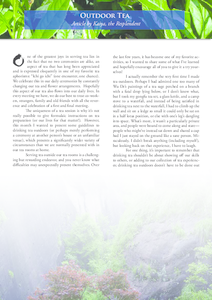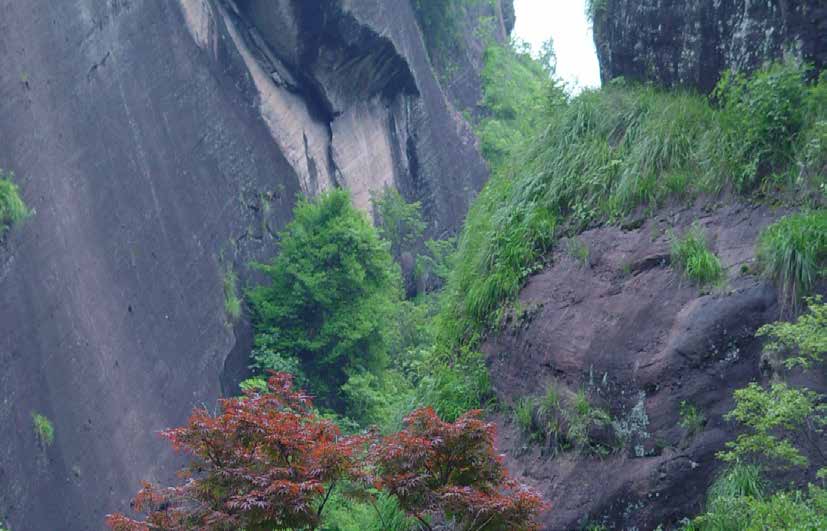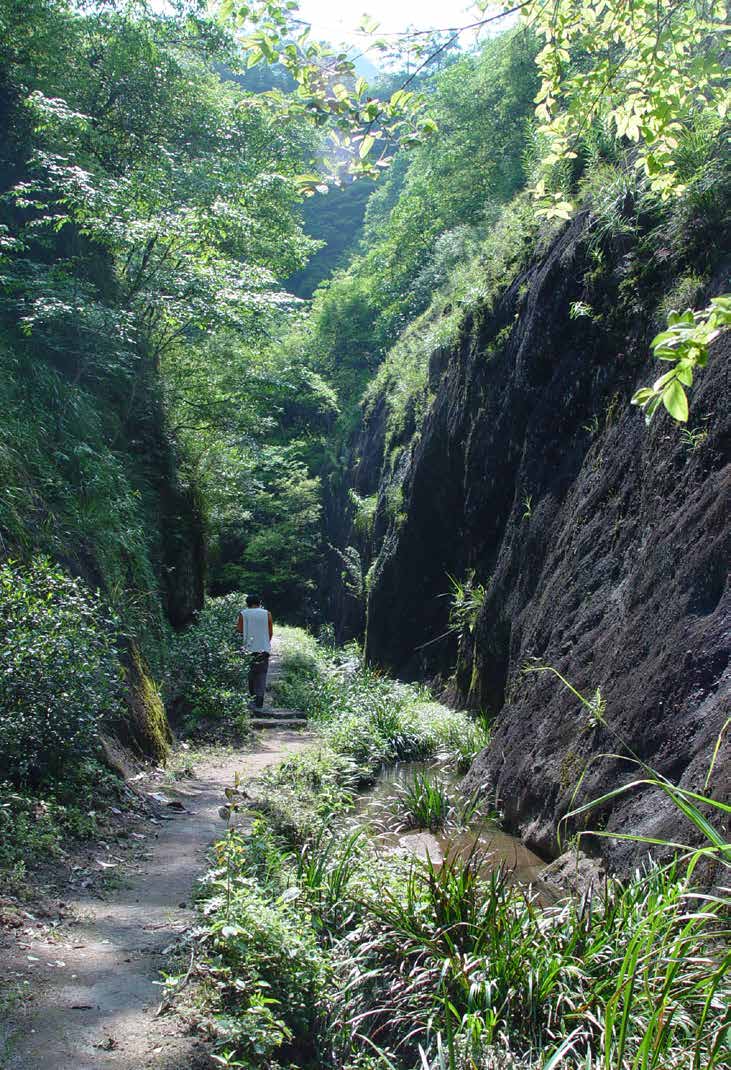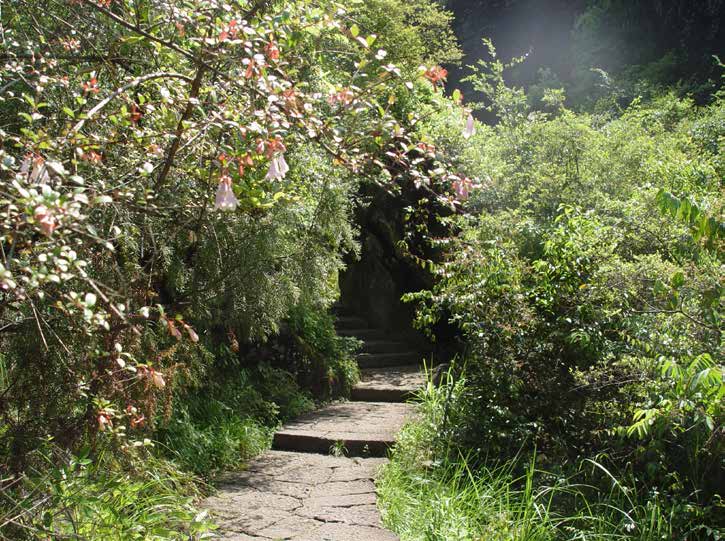
 |
|
One of the greatest joys in serving tea lies in the fact that no two ceremonies are alike, an aspect of tea that has long been appreciated and is expressed eloquently in one of my favorite tea aphorisms: "Ichi go ichi" (one encounter, one chance). We celebrate this in our daily ceremonies by constantly changing our tea and flower arrangements. Hopefully this aspect of our tea also flows into our daily lives. In every meeting we have, we do our best to treat co-workers, strangers, family and old friends with all the reverence and celebration of a first and final meeting.
The uniqueness of a tea session is why it's not really possible to give formulaic instructions on tea preparation (or our lives for that matter!). However, this month I wanted to present some guidelines to drinking tea outdoors (or perhaps merely performing a ceremony at another person's house or an unfamiliar venue), which presents a significantly wider variety of circumstances than we are normally presented with in our tea rooms at home.
Serving tea outside our tea rooms is a challenging but rewarding endeavor, and you never know what difficulties may unexpectedly present themselves. Over the last few years, it has become one of my favorite activities, so I wanted to share some of what I've learned and hopefully encourage all of you to give it a try yourselves!

I actually remember the very first time I made tea outdoors. Perhaps I had admired one too many of Wu De's paintings of a tea sage perched on a branch with a fatal drop lying below, or I don't know what, but I took my gongfu tea set, a glass kettle, and a camp stove to a waterfall, and instead of being satisfied in drinking tea next to the waterfall, I had to climb up the wall and sit on a ledge so small it could only be sat on in a half lotus position, or else with one's leg's dangling into space. What's more, it wasn't a particulary private area, and people were bound to come along and stare - people who might've instead sat down and shared a cup had I just stayed on the ground like a sane person. Miraculously, I didn't break anything (including myself ), but looking back on that experience, I have to laugh.
For one thing, it's important to remember that drinking tea shouldn't be about showing off our skills to others, or adding to our collection of tea experiences; drinking tea outdoors doesn't have to be done out of striving or boredom or getting anyone's attention. Proper tea spirit is one of a desire to share, so choose one of those days where it's sinful to be indoors (you know the ones) and get out there with a desire to share: a gorgeous day with yourself, and with your tea as well! Tea will be as pleased to see the sun and feel a bit of breeze as you are. Secondly, as our brother Steve wrote so beautifully about in past newsletters, if you are going to choose a public place, do so because you are open to sharing that day and that tea with others who may happen to come along.

First things first: pack your tea spirit, and then choose a destination that makes sense. If you really need to go deep into your inner being, perch on a cliff or go somewhere more off the beaten path.
Next, choose suitable teaware. The preservation of teaware is the primary, external purpose behind all movements in a tea ceremony, so it is very important to remember when selecting teaware to take outdoors. Part of respecting your teaware is not endangering it! Not only is it extremely important to pack the teaware you bring with great care (I use both a cloth and a box for each item to be sure) but which teaware you bring is very important as well. We learned this the very hard way ourselves when we once took an antique silver kettle with us to prepare tea outside. Before we could do anything about it, a rambunctious guest took hold of it and began examining it, then just as suddenly dropped it onto a priceless and irreplaceable tea bowl, smashing the bowl to bits and leaving a sizeable dent in the kettle. (I once nearly lost an antique tea cup in much the same way).
We brought this teaware because we wanted to share the best tea we could make with our guests, which is proper tea spirit. But the fact is that outside of your tea room, the uncontrollable factors are tremendously greater--you never know what might happen. In my experience, it's best to leave the gongfu equipment at home and bring along simple bowls, no teapot at all, or perhaps a side-handle pot, and prepare simpler teas as well. There are exceptions to this, like when you are asked to prepare gongfu tea at an event, which sometimes happens.
There is a lot of poetry in this approach to outdoor tea. Drinking bowl tea takes us back to the time of the Daoist mendicants and their mountain huts, drinking tea in the moonlight and beneath waterfalls, merging with Nature and the flow of the Universe. Gongfu tea has more sophistication, more civilization, more of the artistry of man in it than the artistry of Nature, and so it is more at home... well, at home. Which isn't to say gongfu tea can't also be an expression of the flow of the Universe; in fact at its peak that is exactly what it is, and it's just as devoid of Self-expression as bowl tea is, but that's another article. Also, gongfu tea is better enjoyed in smaller, more intimate settings and that generally isn't the case if you are going to brew tea where people are.

So, on to the details... The general inventory will be the same for everything from small to large trips, but there are a lot of personal and situational decisions to make in choosing those items. At the most basic, you will need a kettle, a heat source, bowls, a jen xui (waste water pot) a cloth or a board, water and tea. Personally, even on a small trip without a car, I don't mind carrying a large pack and bringing a full complement of items with me. I will bring two kettles, a heat source, a warming heat source and a side-handle pot almost every time. But sometimes you just want to get out there and make a little tea, and simpler is better. It's nice to have just one kettle and meditate in between the boilings and just take it easy and slow, especially if you know there won't be a stream of people sitting down waiting for you to serve them.
The foremost element in tea, besides the tea, of course, is water. If it's a personal trip and not a big event, I take enough water with me to fill my largest kettle six times, which is enough to give a good session of two different teas, at least for the size of my kettle. Change according to your teaware of course. I find water for sale in a jug of this size at the store, pour the water into my drinking water at home, then refill it with my tea water stored in my water jar at the last possible moment before I leave to ensure my water is of the best quality.
For an indoor event we have to use an electric burner or hotplate (usually) and possibly one of those plug-in electric kettles if we need water very fast all the time. If we're going outdoors, we have to choose between gas and charcoal. For a trip with a car, we take charcoal, a brazier and a warming brazier or alcohol burner to keep one kettle hot while the other boils on the bigger brazier. If I'm alone, hiking with a pack, I will generally choose gas, because even a small brazier is heavy, and the charcoal takes a lot of space and may make a mess in my pack. Simpler is better for pack trips. I like to also bring an alcohol burner if I do take a second kettle, but you have to be careful to store your alcohol in a way it won't spill. But two kettles and an alcohol burner are for a bigger, heavier pack. The simplest thing to do is just bring a single gas burner (you can find small ones at a camping store) and one kettle. Don't forget to bring extra gas and check that your burner is full before you leave!
The rest of your miscellaneous teaware is really up to you, and is fairly personal. You may or may not want to bring a tea scoop to present your tea, for example. I like to bring my tea in a natsume (Japanese tea container), which also protects the tea from being crushed as I carry it. For a jen xui, it's important to bring one made of wood or metal, so it won't break, preferably small in size. If I know I'm going somewhere to sit at a picnic table or on stone, I will bring only a tea cloth. If I don't know the terrain where I will wind up making tea, I will bring a small board, stone, or perhaps an inexpensive tea boat/pillow, on which to set my sidehandle pot, and a long thin piece of wood on which to set my bowls. In both cases, I take a tea cloth to go under it all and usually a cloth to cover the ground where I'll sit. I will also be sure to bring a trivet to set my hot kettle on when not in use so I am not in danger of burning any surfaces, and a tea cloth or two to wipe up any spills and to dry my teaware with after I am finished. I prefer not to take music and enjoy the sounds of Nature, but sometimes the right music can be a nice touch even outdoors. Incense can be a nice touch, but you'll need a lidded censure.
I hope this inspires you to take advantage of your next beautiful day and get out there and share some tea somewhere new. And now hopefully you can leave that sense of "Am I forgetting anything?" behind you, with your trusty comprehensive list provided by yours truly. (Or at the very least the knowledge that now you can Blame Kaiya!™ if anything goes wrong!)
Searching for the Hermit in Vain I asked the boy beneath the pines. He said, "The master's gone alone Herb-picking somewhere on the mount, Cloud-hidden, whereabouts unknown."
